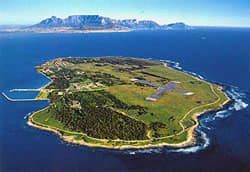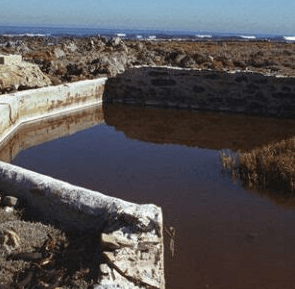Robben Island Museum and Island visits
Early days

When the Dutch first landed at the Cape in 1652, Robben Island was populated mainly with seals and birds. It covers an area of 508 ha. The settlers soon realized that the island was an ideal place to graze cattle and sheep as it was protected from wild animals. There are also natural freshwater springs on the island. Rabbits were introduced in 1685 as an easy source of meat for passing ships.
Quarantine facility
The possibility of using the island as a prison or quarantine facility was also realized early on. The Dutch sent prisoners to the island from 1671 onwards. Before too long, political prisoners and other people who had been banished from the colonies were sent there. In the mid-17th century, it was used to imprison Harry die Strandloper (Autshumao)
.
When the British took over in 1806, they continued this practice and they also built a whaling station.
Leper colony
In 1845, the prisoners had to be taken to the mainland as the island was to be used as a leper colony and a place where other chronically ill or mentally unfit people were held. This even included people who were too sick or old to work and prostitutes who had STDs. These unfortunates were often subjected to treatment which was unhealthy and inhumane and the hospital was eventually closed in 1931.


Robben Island was briefly fortified during World War II and then reinstated as a prison, mainly for political dissidents, in 1961. The prison was closed for political prisoners in 1991 and then shut down altogether five years later.
Museum
Robben Island has now been converted into a museum and has become an extremely popular tourist destination. The museum was first established in 1997 to commemorate the struggle endured by former political prisoners. It is famously known for incarcerating former South African president Nelson Mandela who served 18 of his 27 years of detention during the Apartheid Regime on the island. The island itself was declared a World Heritage Site by UNESCO in 1999.
Tours of the island
Robben Island Museum and Island visits: Tours to Robben Island depart every day at 9 am, 11 am, 1 pm, 3 pm. The tours are weather and demand-dependent.
The tour includes a return trip across Table Bay, a visit to the Maximum Security Prison, on the island and a bus tour of the Island. The excursion takes about 3.5 hours including the ferry trip to and from the Island.
The boat arrives at Murray’s Bay Harbour on the east coast of the Island. Buses transport you to all the historical sites around the Island. The buildings you see with the high wall built by prisoners during the 1960s were used for family and lawyer visits to prisoners.
Tours include sights such as the Robert Sobukwe Complex, The Village Precinct, and World War II Relics. The Banishment fields, The Ou Tronk, The Kramat and the Garrison Church,
Guided walking tours can be arranged that will take you to eight sites: The Murray’s Bay Harbour Exhibition, the Visitor Centre Complex, the Blue Stone Quarry, the World War II Precinct, the Agricultural Precinct, the Limestone Quarry, the Land of Banishment for Xhosa Chiefs, the Ou Tronk Exhibition, and the Maximum Security Prison
De Waal Battery
De Waal Battery on Robben Island consists of three 9.2-inch BL guns placed over a 500-metre frontage. The Number 3 gun has been fully restored and is likely the last operational 9.2-inch gun in the World. The No. 3 gun was manufactured by the Royal Gun Factory at Woolwich, London, in 1901. It arrived in the Cape in November 1940 and it weighed 140 tons. Each piece of the gun was brought from the mainland using a specially constructed barge. The gun had a range of almost 30 km
Jan se gat
The Jan van Riebeeck Quarry on the island was started in 1652 and is the oldest quarry on Robben Island. It is also known as Jan se Gat and it was extensively mined for slate used in the construction of Cape Town. The quarry was worked intermittently for about 300 years and was closed in 1963.

The Bath of Bethesda
During the time that the island was used as a leper colony, it was thought that seawater was beneficial for those living with the disease. A tidal pool was constructed so that affected patients could bathe. The remains of this pool, called the Baths of Bethesda, are still visible today. The lepers of the Cape were torn away from their families and friends and dumped on the island.
 The Bath of Bethesda
The Bath of Bethesda
Living Conditions on the Island
The Robben Island airfield was used by the apartheid government for the air transport of officials. The airfield is currently only used by VIP guests
The Jetty Museum building was, in fact, the start and endpoint of the journeys taken by all travellers – prisoners, wardens, or staff heading to and from Robben Island. A little board just outside the entrance denotes its historical importance. Inside the museum is a full account of Robben Island, before and after apartheid. The holding cells here are very similar to the cells on the island, with hard beds and empty benches in the waiting room. Jetty 1 also has a little museum that used to be a prison. It is now a national monument. This is from where the boat leaves and it was originally known as the east jetty. It was the first jetty built in the Victoria Basin and it was closely associated with Robben Island way before apartheid when the island was used by the British as a convict station and hospital. In 1961, when the island became a maximum-security prison, the jetty was used exclusively by prison services. It was the only way to reach Robben Island. The original building was little more than a shack made from corrugated iron sheeting. The current building was constructed in the 1970s
Seabirds
Robben Island is also regarded as a hotspot for seabird biodiversity and is a base for African black oystercatchers, sacred ibis, cattel egrets, little egrets and bank cormorants, and a colony of jackass penguins. When the Dutch originally arrived at the Cape, penguins dominated Robben Island. But by 1800 there were no more. They had been decimated by hungry settlers and sailors wanting to vary their diet, which consisted largely of rabbits introduced in 1685 as a source of meat for passing ships
Stay on the island
Robben Island’s Guest House accommodates 15 guests. The accommodation is, however, self-catering as there are no restaurant facilities on the island.
Get married on Robben Island
The Garrison Church on the island can accommodate 80 guests
Private tours, accommodation and venue hire prices are available on request
Nelson Mandela Gateway at the V & A Waterfront.
Pensioners discount on Mondays and Wednesdays


